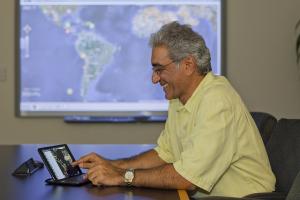UH managed Pacific Disaster Center aids fight against Zika
University of Hawaiʻi*Link to video and sound: http://bit.ly/1UJvn0l
(details below)
The Zika virus is one of the latest threats the University of Hawai‘i managed Pacific Disaster Center (PDC) is helping to combat with its global array of technological solutions and services.
The center has been monitoring and mapping outbreaks and providing regular products to the U.S. government as well as international agencies involved in the strategic response to the mosquito born disease. PDC’s DisasterAWARE platform used for their support includes not only easy visualization and integration of environmental and health data, but it’s also equipped with thousands of national and subnational infrastructure data, such as hospitals and airports, and observational data, such as accumulated rainfall.
The University of Hawai‘i was recently awarded a 5-year cooperative agreement by the U.S. Department of Defense to continue to serve as Managing Partner of the Pacific Disaster Center on Maui.
PDC delivers comprehensive disaster risk reduction solutions—including risk and vulnerability assessment and innovative tools and services—to disaster managers and the public to help avoid hazards becoming disasters and disasters becoming crises. The Center’s DisasterAWARE software product is regularly used by primary disaster management agencies in Hawai‘i, by U.S. federal agencies such as the Departments of Defense, Homeland Security, and State, as well as by disaster management agencies in countries around the globe, and even by the United Nations. Customized versions of DisasterAWARE have also been delivered to agencies in Thailand, Vietnam, Indonesia and the Association of South East Asian Nations (ASEAN).
PDC Executive Director Ray Shirkhodai said, “This vote of confidence by the U.S. government in our work is a testament to the success of our entire team in advancing our mission. The capabilities of UH and RCUH have enabled us to meet the unique needs of our stakeholders and customers in Hawai‘i, throughout the U.S., among nations in Asia and beyond.”
Over the past nine years PDC has substantially increased its project funding beyond the base cooperative agreement, now matching its base funding each year through entrepreneurial business development with public and private partners in the U.S. and internationally. PDC has also expanded its services to include a new mobile application, Disaster Alert for Android and iOS, which has been downloaded more than 1.6 million times and is recognized globally as one of the premiere mobile apps for disaster information and management. PDC’s Global Hazards Atlas, a publicly available interactive map for hazard monitoring and early warnings, is another popular tool.
UH has served as managing partner for PDC since 2006, when it was first selected through a competitive process to assume management responsibility. The agreement was again awarded to UH in 2009 for six years, and was renewed in 2015 for an additional five years. Additionally, based on the success of the program the new cooperative agreement was expanded from the base agreement of about $30 million to include a ceiling of $75 million for the performance period.
PDC Principal Investigator, UH President David Lassner, noted, “This is a compelling example of how UH is helping Hawai‘i and the world. PDC offers some of the best high tech jobs on Maui, many of which go to our own student interns when they graduate. And every day the PDC team is making people safer through the deployment of PDC technologies, programs, education and training."
Link to video and sound: http://bit.ly/1UJvn0l
B-Roll TRT 1:30
IN OUT DESC
:00 :04 Ray Shirkhodai at PDC video projection screen
:04 :09 Zika Virus PDC web page
:09 :13 Another Zika Virus PDC screen
:13 :18 Dengue Fever mosquitoes on PDC web page
:18 :24 Shirkhodai in silhouette at projection screen
:24 :31 touch screen globe spinning with finger
:31 :39 PDC headquarters on Maui exterior
:39 :45 PDC headquarters on Maui interior
:45 1:11 4 shots demonstrating PDCʻs free Disaster Aware app on iPad
1:11 1:29 5 shots of PDC employee with projection screen
Ray Shirkhodai, Executive Director, Pacific Disaster Center (:27) (on having worked with the government to collect subnational data such as hospital availability in Latin America and South America for many years)
“Now combining that information along with the Zika virus and how it spreads and where it may be most pervasive would provide a lot more insight into what one might expect, which nations may be better prepared and what not, and those are the type of products that besides just monitoring the event that our center is actively producing.”
Ray Shirkhodai (:15) (on the impact of the new 5 year management agreement with the University of Hawai‘i for a base of $30 million and a ceiling of $75 million)
“Over 90 percent of our center’s spending happens in Hawai‘i. We do almost everything, including all of our software development, all of our experts and what not are in Hawai‘i.”
Flickr link to PDC photos: https://www.flickr.com/photos/uhawaii/albums/72157665096482685
Link to the Pacific Disaster Centerʻs Zika-related maps: http://www.pdc.org/event-dashboard/Zika_Virus/

